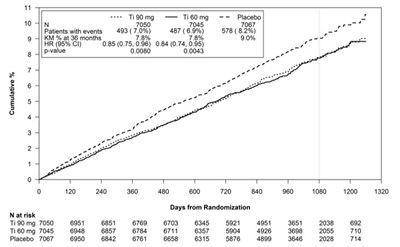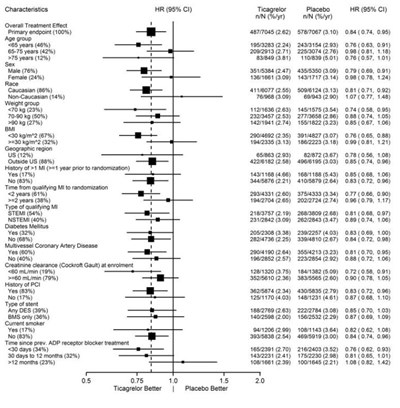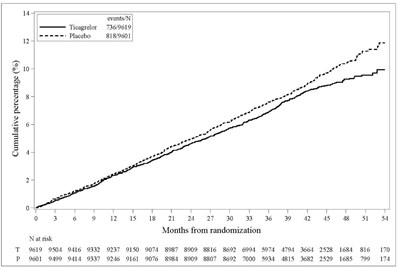Product Images Brilinta
View Photos of Packaging, Labels & Appearance
Product Label Images
The following 20 images provide visual information about the product associated with Brilinta NDC 55154-9618 by Cardinal Health 107, Llc, such as packaging, labeling, and the appearance of the drug itself. This resource could be helpful for medical professionals, pharmacists, and patients seeking to verify medication information and ensure they have the correct product.
Figure 1
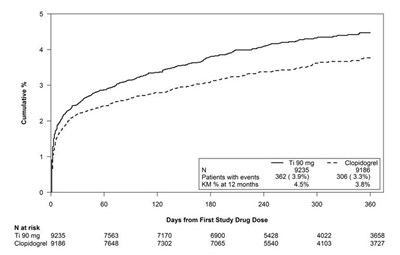
This appears to be a table displaying data related to two drugs, Tigomg and Clopidogrel. The data shows the number of patients with events and the percentage of events at 12 months for each drug. The table also shows the number of patients at risk for each drug at various time points following the first drug dose. It is unclear what type of events are being referred to or what the drugs are used for.*
Figure 2

This is a graph showing the percentage of patients who experienced an event following Coronary Artery Bypass Grafting (CABG), plotted against the number of days post-surgery. The percentages are shown on the y-axis and range from 0-100%, while the x-axis shows the number of days after surgery. The graph also includes a table with numerical values that correspond to various time points.*
figure 16

The excerpt provides data from a study (full analysis set) regarding patients who are treated with Ticagrelor. It includes different factors such as age, sex, race, body mass index, geographic region, HbAle at baseline, eGFR at baseline, insulin use, history of angina, multivessel coronary artery disease, history of PCI or CABG, diabetes, and duration of diabetes, and it presents the HR (with 95% CI) of Ticagrelor over the placebo in different categories.*
figure 17

The text provides statistics of a clinical trial evaluating the efficacy of Ticagrelor 90 mg bd versus placebo. The trial involved 5523 participants receiving Ticagrelor and 5493 receiving placebo. The percentage of events was 5.4% and 6.5%, respectively. The text also shows a graph where "days from randomization" is presented in the x-axis and "N at risk" in the y-axis. There is not enough information to know the nature or type of the events, nor the purpose of the graph presented.*
figure 18
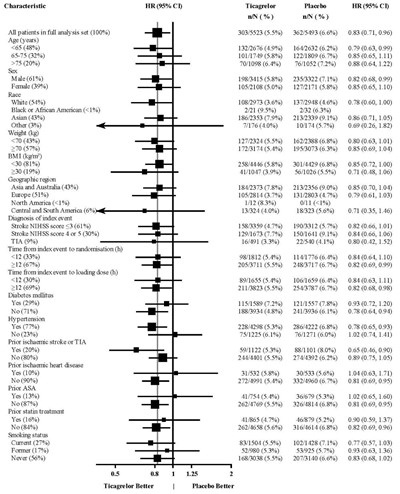
This text seems to be a statistical report using HR (hazard ratio) to compare the efficacy of the drugs Ticagrelor and Placebo in treating patients with an index event (stroke or TIA). It provides data on characteristics of the patients in the full analysis set, such as age, sex, race, weight, and medical history. It also lists the geographic regions where the study was conducted and the time from index event to randomization and loading dose. However, it is not possible to clearly understand the format and meaning of the data presented without a more detailed context or explanation.*
figure 3

This is a table showing the results of an event involving the medication Ticagrelor versus Placebo. It includes the number of patients who experienced the event out of the total number of patients in each group. There is also a chart displaying the cumulative percentage over time, with months since randomization on the X-axis and the percentage on the Y-axis. The text does not provide information about what the event or medication is.*
figure 4

This text seems to be a medical chart showing the cumulative percentage of events and the number of patients who took Ticagrelor 90 mgbd compared to those who took Placebo, along with days from randomization. However, without additional context, it's difficult to provide more information.*
figure 7

The given text relates to the mean effect and 90% CI of Ticagrelor AR-CI24910XX drug for patients with intrinsic factors like age, gender, ethnicity, renal impairment, and hepatic impairment. The recommendation for dose adjustment or non-adjustment based on these intrinsic factors is mentioned in the text. However, the results or effect of the drug are not clearly stated, making it difficult to determine its efficacy.*
image 09

This document appears to be a table displaying recommended dosage adjustments for patients taking Ticagrelor (BRILINTA) who are also taking other medications. The table lists various interacting drugs and provides recommendations for dose adjustment of Ticagrelor based on the interaction. The text also includes a note that similar pharmacokinetic results were observed on August 31, but there is not enough context to determine what this refers to.*
* The product label images have been analyzed using a combination of traditional computing and machine learning techniques. It should be noted that the descriptions provided may not be entirely accurate as they are experimental in nature. Use the information in this page at your own discretion and risk.






